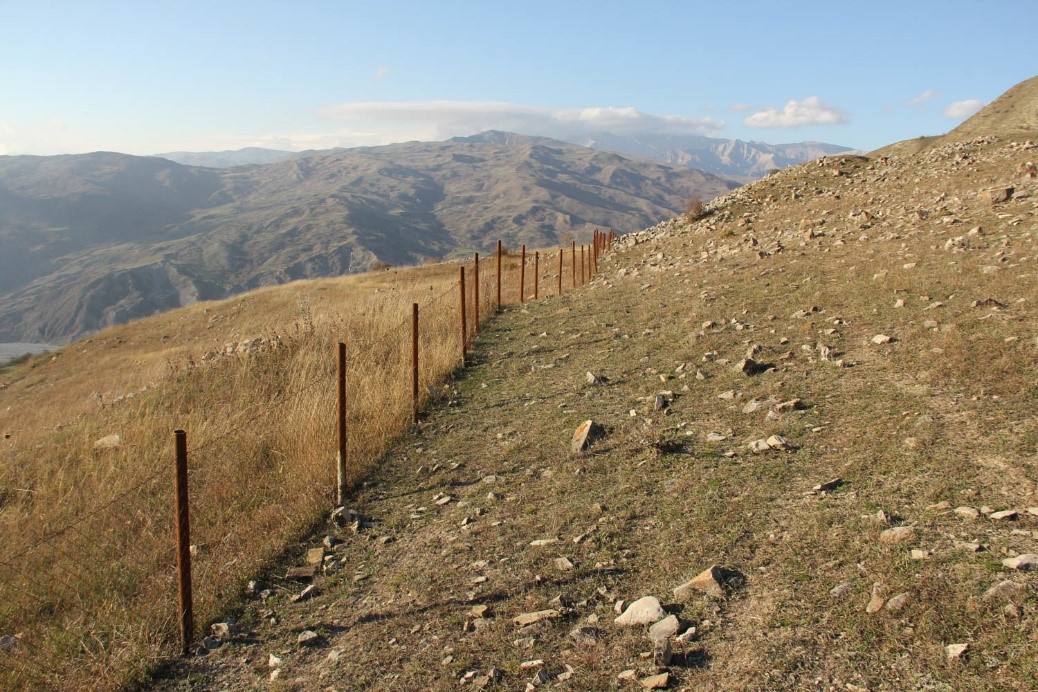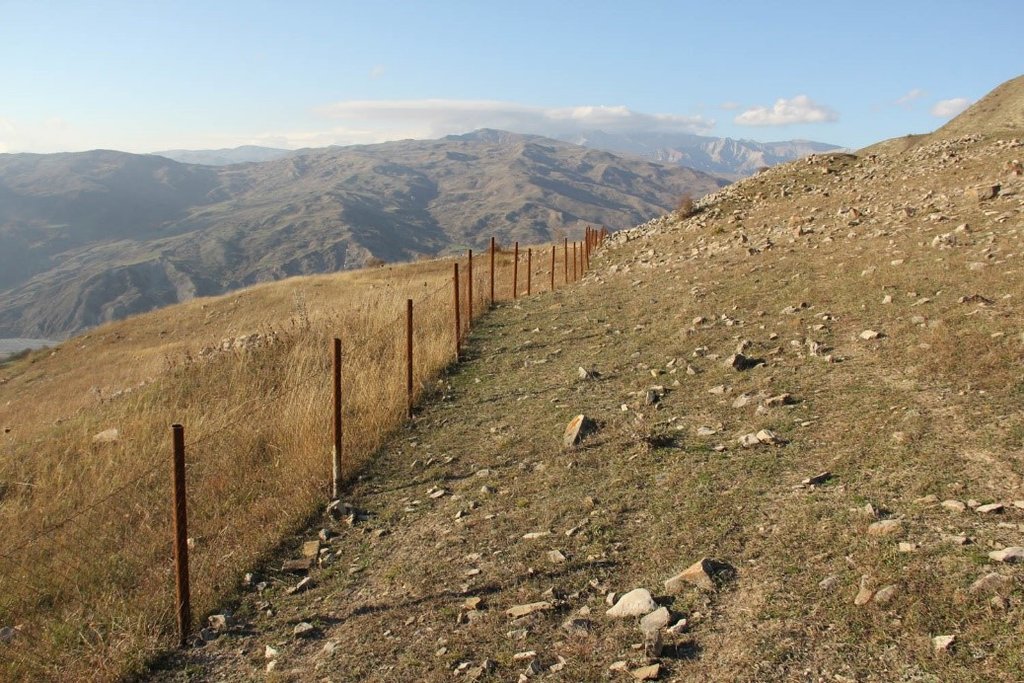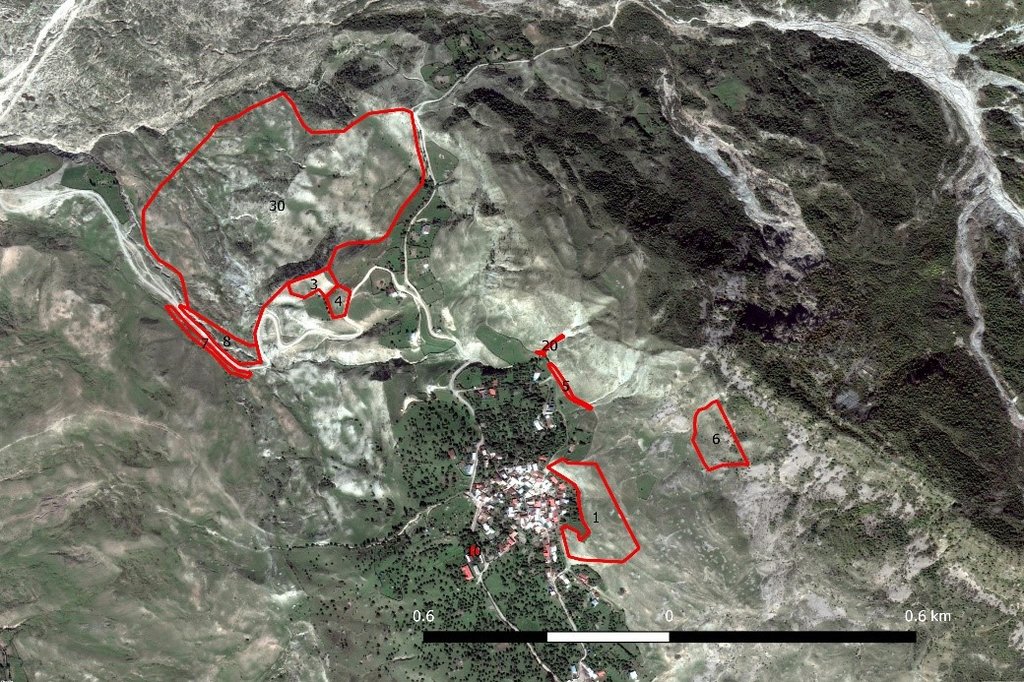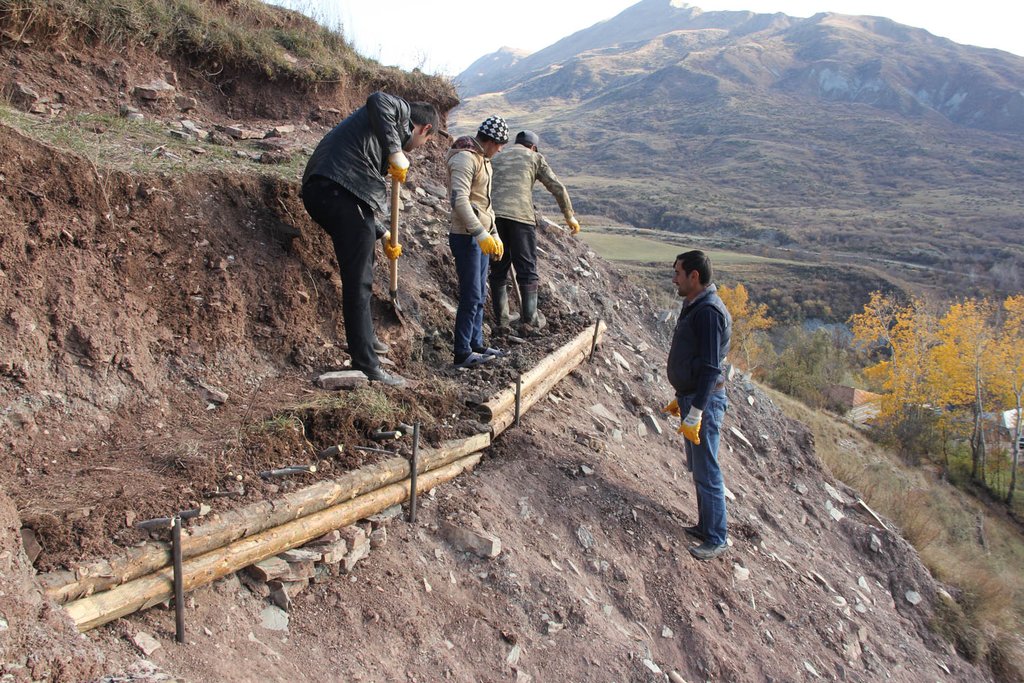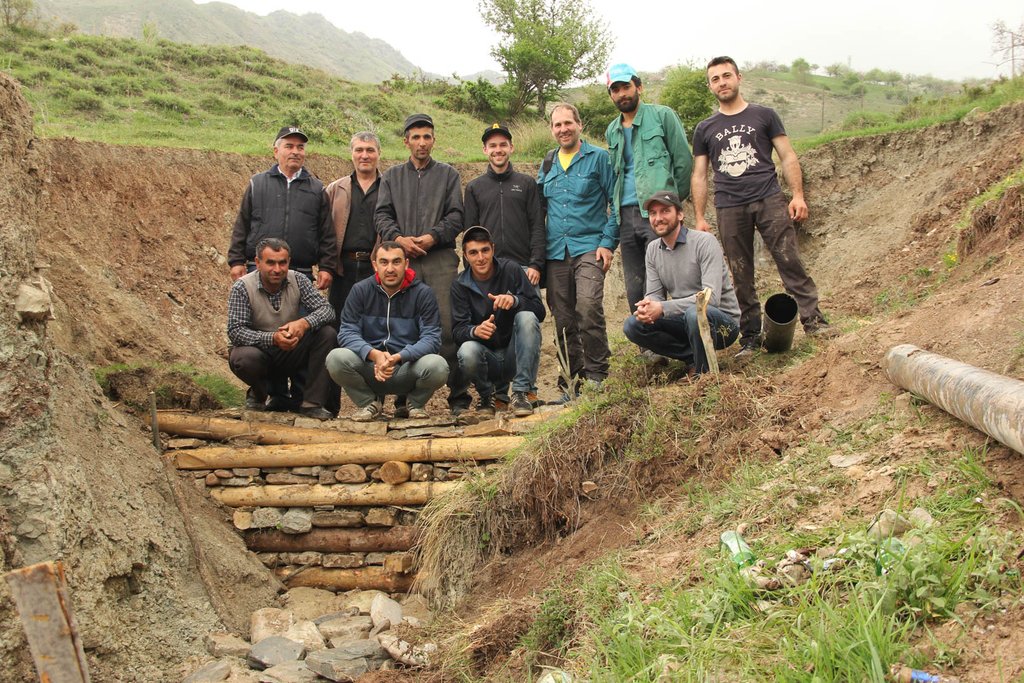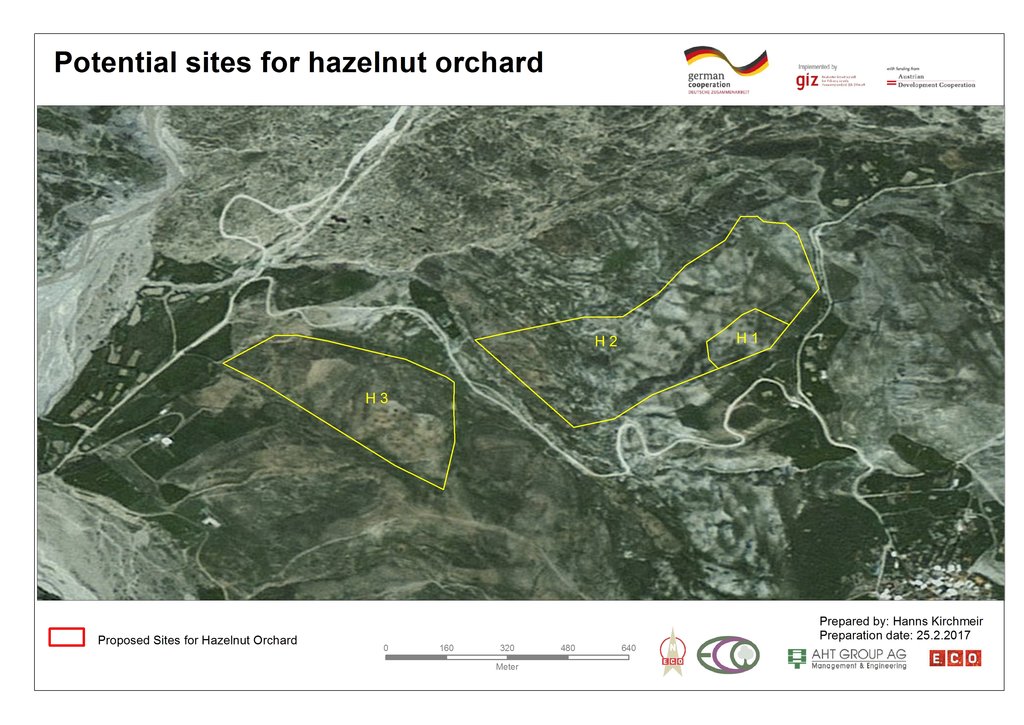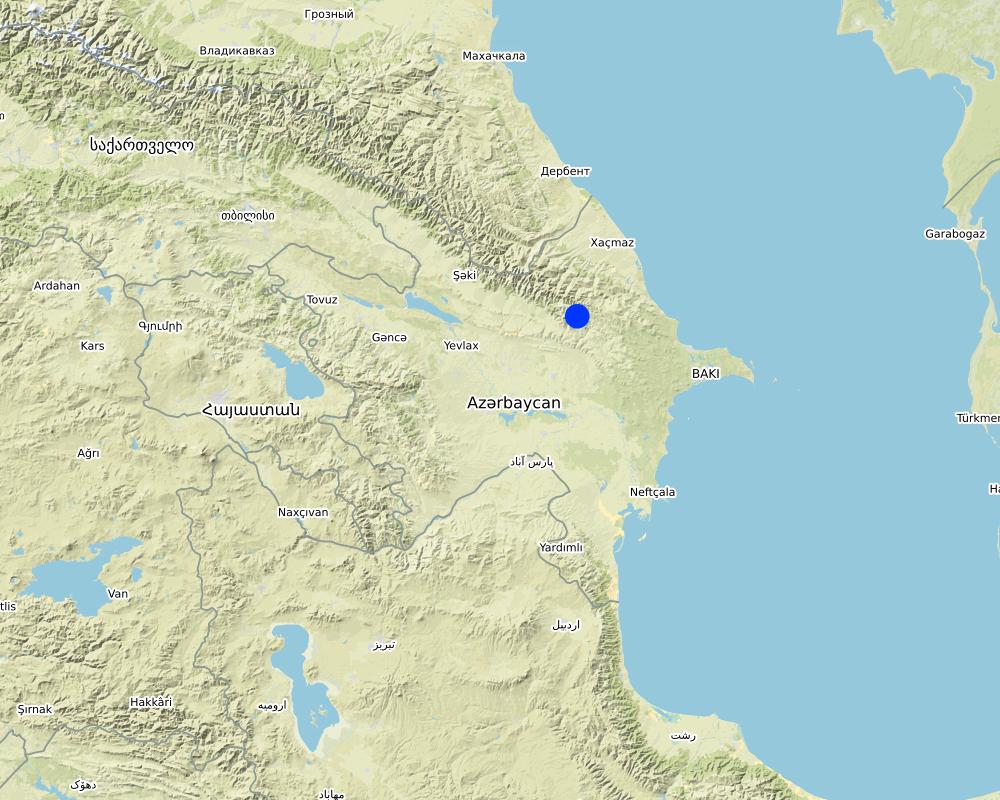Community-based approach in Erosion Control [ប្រទេសអាស៊ែបៃហ្សង់]
- ការបង្កើត៖
- បច្ចុប្បន្នភាព
- អ្នកចងក្រង៖ Hanns Kirchmeir
- អ្នកកែសម្រួល៖ Markus Koeppler, Samir Abbasov
- អ្នកត្រួតពិនិត្យ Rima Mekdaschi Studer
Ismayilly district, Ehen community
approaches_5571 - ប្រទេសអាស៊ែបៃហ្សង់
ពិនិត្យមើលគ្រប់ផ្នែក
ពង្រីកមើលទាំងអស់ បង្រួមទាំងអស់1. ព័ត៌មានទូទៅ
1.2 ព័ត៌មានលម្អិតពីបុគ្គលសំខាន់ៗ និងស្ថាប័នដែលចូលរួមក្នុងការវាយតម្លៃ និងចងក្រងឯកសារនៃវិធីសាស្ត្រផ្សព្វផ្សាយ
អ្នកជំនាញឯកទេស SLM:
ឈ្មោះគម្រោងដែលបានចងក្រងឯកសារ/ វាយតម្លៃលើវិធីសាស្ត្រផ្សព្វផ្សាយ (បើទាក់ទង)
Integrated Biodiversity Management, South Caucasus (IBiS)ឈ្មោះអង្គភាពមួយ (ច្រើន) ដែលបានចងក្រងឯកសារ/ វាយតម្លៃលើវិធីសាស្ត្រផ្សព្វផ្សាយ (បើទាក់ទង)
Deutsche Gesellschaft für Internationale Zusammenarbeit (GIZ)1.3 លក្ខខណ្ឌទាក់ទងទៅនឹងការប្រើប្រាស់ទិន្នន័យដែលបានចងក្រងតាមរយៈវ៉ូខេត
តើពេលណាដែលទិន្នន័យបានចងក្រង (នៅទីវាល)?
31/10/2018
អ្នកចងក្រង និង(បុគ្គលសំខាន់ៗ)យល់ព្រមទទួលយកនូវលក្ខខណ្ឌនានាទាក់ទងទៅនឹងការប្រើប្រាស់ទិន្នន័យដែលបានចងក្រងតាមរយៈ វ៉ូខេត:
បាទ/ចា៎
1.4 ការយោងមួយ (ច្រើន) ទៅលើ (កម្រង) បញ្ជីសំណួរនៃបច្ចេកទេស SLM
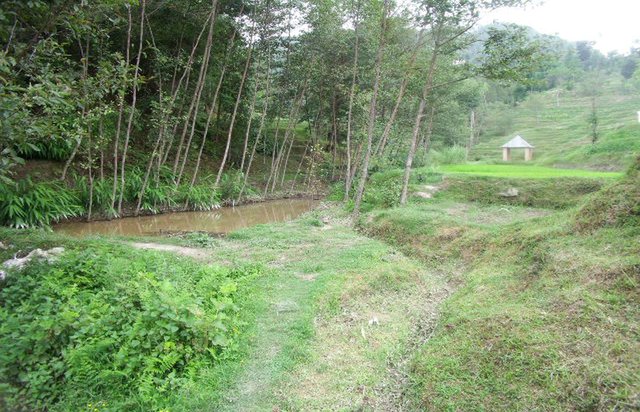
Sustainable land management using controlled gullying [ប្រទេសនេប៉ាល់]
An indigenous technology to help control channelled water during the rainy season and conserve it during the dry season
- អ្នកចងក្រង៖ Shreedip Sigdel
2. ការពណ៌នាអំពីវិធីសាស្ត្រផ្សព្វផ្សាយ SLM
2.1 ពណ៌នាសង្ខេបខ្លីពីវិធីសាស្ត្រផ្សព្វផ្សាយ
The unsustainable use of pastures and forest areas leads to erosion, degradation, desertification and loss of biodiversity in high mountain areas of the South Caucasus. In the village Ehen in the Ismayilli district in Azerbaijan, a community-based approach for erosion control was developed in a participative way. Together with village stakeholders, different measures were developed to stop erosive processes, flooding and to rehabilitate vegetation cover.
2.2 ពណ៌នាលម្អិតពិវិធីសាស្ត្រផ្សព្វផ្សាយ
ពណ៌នាលម្អិតពិវិធីសាស្ត្រផ្សព្វផ្សាយ:
The Ministry of Ecology and Natural Resources of Azerbaijan togehter witht the Deutsche Gesellschaft fuer Zusammenarbeit (GIZ) selected integrated erosion control as a priority in their cooperation and the district Ismayilli was choosen for the implementation of pilot activities.
The district Ismayilli covers an area of about 2.158 km². Approximately 31% of the territory is covered with forest. Pasture lands on slopes are particularly exposed to vegetation degradation due to overgrazing. The loss of a closed vegetation cover on mountain slopes can lead to severe soil erosion due to surface water runoff. The project team together with the district administration decided to set the focus on the village Ehen near Lahic.
The approach chosen for integrated erosion control in Ehen was a community-based approach. Together with stakeholders, the most severe erosion sites were identified, and a list of priorities was developed. In cooperation with international experts, different technologies and practices were developed to stop erosion processes. Several preconditions for the development of a number of practices were set: The technologies should be cost-effective and affordable for the villagers, and the villagers should be able to use them without the use of external technicians. In order to achieve this, particular emphasis was placed on the application of bio-engineering measures. Measures were applied on degraded pasture lands and erosion gullies in the pilot community at the south slope of the Great Caucasus.
As a first step, the implementation sites were determined through joint field visits by village representatives and experts ('Screening mission'). In the first face the GIZ-team and the SLM-experts have been introduced to the village community. In this phase, the national GIZ project coordinator had the major role to create a basis of respect and trust to enable a positive athomisphere for an open minded discussion. The driving factors of deforestation and overgrazing were discussed in the field, and the potential intervention sites were marked with colour spray and wooden poles in the field. The marking in the field instead of only working with printed maps was very important for the recognition, discussion and acceptance of the sites by all villagers. There was a gap of several weeks between marking and implementation, which provided enough time for internal discussion about the site selection and the adaptation of boundaries.
Nine degraded pastures and forest land sites were selected by the village stakeholders togehter witht the SLM specialists. Four sites are located above the village with the risk of increasing rockfall and flooding by surface water runoff. Five sites are located below the village and were selected to ensure the productivity of the land. For providing tree seedlings, a local tree nursery was established near the school (10th site). One site was selected to combine effects by establishing a hazelnut plantation to stop erosion, increase vegetation cover and provide an income generation opportunity.
Two sites with gully erosion were selected: a site above the village with the risk of flooding into the village and a site below the village along the road with a high risk of road damage if the deepening process continues (detailed instructions on measures can be found at the internet links attached).
Regular meetings took place between the traditional administrative community board, the GIZ-project team and the SLM experts to discuss the implementation process and to evaluate together the results. The availability of local resources was taken into consideration to adapt technologies to fit the local needs. New ideas, localy available materials and technologies have beein integrated into the implementation process by the local stakeholders.
The implementation of the measures was done mainly by the local village people and local experts. The SLM experts provided 'hands-on-training' and all materials that were not available in the village as well external experts were financed by the project.
Another essential aspect is the sustainable use of well-managed meadows by different stakeholders (beekeepers, wild herb collectors, orchard owners and others) in the community. This includes the agreement (rule) of the community to share the protected pastures and to consider the needs of all interest groups. The decission of the profit sharing is taken by the taditional administrative community board. A further factor was the establishment of a tree nursery, which led to an increased motivation to plant additional trees (especially fruit trees) in the community.
2.3 រូបភាពនៃវិធីសាស្ត្រផ្សព្វផ្សាយ
កំណត់សំគាល់ទូទៅរបស់រូបថត:
The soil condition is very poor regarding humus.
2.4 វីឌីអូនៃវិធីសាស្ត្រផ្សព្វផ្សាយ
2.5 ប្រទេស/តំបន់/ទីតាំងកន្លែង ដែលវិធីសាស្ត្រផ្សព្វផ្សាយត្រូវបានអនុវត្តន៍
ប្រទេស:
ប្រទេសអាស៊ែបៃហ្សង់
តំបន់/រដ្ឋ/ខេត្ត:
Ehen village
បញ្ជាក់បន្ថែមពីលក្ខណៈនៃទីតាំង:
DIistrict Ismayilli
មតិយោបល់:
The pilot sites belong to Ehen village within the district Ismayilli.
Map
×2.6 កាលបរិច្ឆេទនៃការចាប់ផ្តើម និងបញ្ចប់នៃវិធីសាស្រ្តផ្សព្វផ្សាយនេះ
សូមបញ្ជាក់ឆ្នាំដែលបានបង្កើតឡើង:
2015
ប្រសិនអត់ចាំឆ្នាំ សូមចង្អុលបង្ហាញកាលបរិច្ឆេទប្រហែលៗពេលដែលវិធីសាស្ត្រផ្សព្វផ្សាយត្រូវបានចាប់ផ្តើមប្រើ:
តិចជាង 10ឆ្នាំមុន (ថ្មី)
ឆ្នាំបញ្ចប់ (ប្រសិនបើវិធីសាស្ត្រផ្សព្វផ្សាយត្រូវបានឈប់ប្រើប្រាស់):
2018
មតិយោបល់:
At the 10 locations of the village Ehen the implementation of the approach took place in the years 2016-2018.
2.7 ប្រភេទនៃវិធីសាស្ត្រផ្សព្វផ្សាយ
- ផ្អែកលើគម្រោង/កម្មវិធី
2.8 គោលបំណង/ទិសដៅសំខាន់នៃវិធីសាស្ត្រផ្សព្វផ្សាយ
Develop erosion control measures that can be implemented by village population without significant investment. The measures are addressed to rehabilitate vegetation on eroded sites and to slow down water speed and erosive energy where gullies already exist. This should help protect roads and other infrastructure as well as stop soil loss and increase overall productivity.
2.9 លក្ខខណ្ឌអនុញ្ញាត ឬរារាំងការអនុវត្តន៍បច្ចេកទេសដែលស្ថិតនៅក្រោមវិធីសាស្រ្តផ្សព្វផ្សាយ
សង្គម/វប្បធម៌/ និងតម្លៃនៃសាសនា
- អំណោយផល
Local population tend to save resources such as forest and pasture surrounding their village. Residents, especially women collect wild plants to use in daily life. Furthermore, selling collected wild plants in the market, residents earn income.
ភាពអាចរកបាននៃធនធានហិរញ្ញវត្ថុ និងសេវាកម្ម
- អំណោយផល
Most of the activities (fencing, willow fascines, pilewalls, gabion or wooden check dams) only need small-scale financial investments. Only the drip irrigation system for the hazelnut orchard needed significant external investment, and the return of the investment cannot be expected before 10 years. Such an investment would have been impossible for the village community without external support.
បរិបទនៃស្ថាប័ន
- អំណោយផល
The Community Management Group was established at the early stage of the project.
ការសហការ/ការសម្របសម្រួលតួអង្គពាក់ព័ន្ធ
- អំណោយផល
Pilot activities are implemented in cooperation with local decision makers and communities. The active involvement of the village people in the implementation works was a hands-on training.
ក្របខណ្ឌច្បាប់ (សិទ្ធិកាន់កាប់ដីធ្លី កម្មសិទ្ធីប្រើប្រាស់ដីនិងទឹក)
- រារាំង
The forest’s legal protection does not allow timber or poles to be taken from the forest for the construction of pile walls or wooden check dams. The poles had to be imported and transferred to the village. A balanced sustainable forest management would enable village people to make use of the local timber and would encourage people to establish forest areas.
គោលនយោបាយ
- អំណោយផល
The Azerbaijan policy to establish more than 2000ha of hazelnut orchard in the district of Ismayilli supports the decision to establish hazelnut orchards on eroded sites as a control measure.
អភិបាលកិច្ចដី (ការសម្រេចចិត្ត ការអនុវត្ត និងការរឹតបន្តឹង)
- អំណោយផល
Pilot sites are located in municipality land. Community members and local authority decided the border of pilot sites.
ចំណេះដឹងស្តីពី SLM និងការទទួលបានការគាំទ្រផ្នែកបច្ចេកទេស
- អំណោយផល
Residents have some initial knowledge of sustainable land management. Implementing pilot activities their information is developed.
ទីផ្សារ (ទិញធាតុចូល លក់ផលិតផល) និងតម្លៃ
- អំណោយផល
Collected wild plants are sold in the market located next to Ehen village.
ទំហំការងារ ភាពអាចរកបាននៃកម្លាំងពលកម្ម
- អំណោយផល
The manpower is available in the village
3. ការចូលរួម និងតួនាទីរបស់ភាគីពាក់ព័ន្ធ
3.1 អ្នកពាក់ព័ន្ធដែលបានចូលរួមក្នុងវិធីសាស្ត្រផ្សព្វផ្សាយ និងតួនាទីរបស់ពួកគេ
- អ្នកប្រើប្រាស់ដីក្នុងតំបន់/សហគមន៍
Livestock farmers, shepherds, smallholder farms and women that were loosely organised.
Selection of sites for intervention, providing labour during implementation of measure, local hay residuals provided by farmers for testing the measure, maintenance of drip irrigation and electric fence of the hazelnut orchards.
- អ្នកឯកទេសគ្រប់គ្រងដីប្រកបដោយចីរភាព/ទីប្រឹក្សាបច្ចេកទេសកសិកម្ម
International and national specialists have been integrated.
The SLM specialist elaborated in close cooperation with the local stakeholders the implementation concept.
- អ្នកស្រាវជ្រាវ
Researcher from the Agrarian University in Ganja.
- រដ្ឋាភិបាលថ្នាក់មូលដ្ឋាន
Ministry of Ecology and Natural Resources, Ismayilli District Administration
Numerous pilot activities (test and demonstrate the most appropriate actions and raise awareness of the community on the long-term socio- economic and environmental benefits of the pilot actions) have been implemented In cooperation with local government in Ehen municipality.
3.2 ការចូលរួមរបស់អ្នកប្រើប្រាស់ដីក្នុងតំបន់/ សហគមន៍ក្នុងតំបន់ក្នុងដំណាក់កាលផ្សេងគ្នានៃវិធីសាស្រ្តផ្សព្វផ្សាយ
| ការចូលរួមរបស់អ្នកប្រើប្រាស់ដីក្នុងតំបន់/សហគមន៍ក្នុងតំបន់ | សូមបញ្ជាក់នរណាត្រូវបានចូលរួម ព្រមទាំងពណ៌នាសកម្មភាពទាំងនោះ | |
|---|---|---|
| ការចាប់ផ្តើម/ការលើកទឹកចិត្ត | គ្មាន | The selection of Ismayilli district was done at Ministry level. The selection of the villages was done with district administration and experts assessment of erosion problems. |
| ការរៀបចំផែនការ | អន្តរកម្ម | The site selection was done with local village stakeholders. The technical planning was done by external experts. Four additional municipalities were assessed for hazelnut plantations where local land users provided data. |
| ការអនុវត្តន៍ | អន្តរកម្ម | Local stakeholders trained on bioengineering measures. The following measures were applied during hands-on training: 1. Wooden check-dam. 2. Gabion check-dam. 3. Willow-fascines. 4. Electric-Fencing. 5.Pile walls. 6.Drip irrigation system. |
| ការត្រួតពិនិត្យ និងវាយតម្លៃ | អន្តរកម្ម | An external monitoring team (project team) did the monitoring in a participative way. The observations and monitoring results were discussed with the village stakeholders. |
3.3 គំនូសបំព្រួញ (ប្រសិនបើមាន)
ការពណ៌នា:
This flow chart gives an overview on the different roles of project participants (Ministry and GIZ, the national experts and SLM specialists as well as the local stakeholders) and the actions implementented by them jointly or seperately.
3.4 ការសម្រេចចិត្តលើការជ្រើសរើសបច្ចេកទេស SLM
សូមបញ្ជាក់តើអ្នកណាជាអ្នកបានសម្រេចចិត្តក្នុងការជ្រើសរើសបច្ចេកទេសដើម្បីយកមកអនុវត្តន៍:
- អ្នកជំនាញឯកទេស SLM បន្ទាប់ពីបានប្រឹក្សាយោបល់ជាមួយអ្នកប្រើប្រាស់ដី
ចូរពន្យល់:
The integrated erosion control measures were developed by SLM specialists, while site selection and prioritization were done in conjunction with village community representatives.
សូមបញ្ជាក់ តើការសម្រេចធ្វើឡើងដោយផ្អែកលើអ្វីជាមូលដ្ឋាន:
- លទ្ធផលបានពីការស្រាវជ្រាវ
- បទពិសោធន៍ និងគំនិតផ្ទាល់ខ្លួន(ពុំមានចងក្រងជាឯកសារ)
4. ជំនួយបច្ចេកទេស ការកសាងសមត្ថភាព និងការគ្រប់គ្រងចំណេះដឹង
4.1 ការកសាងសមត្ថភាព/ បណ្តុះបណ្តាល
តើវគ្គបណ្តុះបណ្តាលបានផ្តល់ឱ្យអ្នកប្រើប្រាស់ដី/អ្នកពាក់ព័ន្ធផ្សេងៗទៀតដែរឬទេ?
បាទ/ចា៎
សូមបញ្ជាក់តើអ្នកណាត្រូវបានបណ្តុះបណ្តាល:
- អ្នកប្រើប្រាស់ដី
- បុគ្គលិកចុះទីវាល/អ្នកផ្តល់ប្រឹក្សាយោបល់
ប្រសិនទាក់ទង សូមបញ្ជាក់ ភេទ អាយុ ស្ថានភាពគ្រួសារ ជនជាតិដើមភាគតិច។ល។:
Only men have been involved in the training of the application of the erosion control measures.
ទម្រង់នៃការបណ្តុះបណ្តាល:
- អនុវត្តន៍ជាមួយការងារ
- ទីតាំងបង្ហាញ
ប្រធានបទបណ្តុះបណ្តាល:
Construction of willow fascines, pill walls, wooden check dams, gabion check dams, tree planting, fence construction (electric fence, mesh wire fence), construction and maintenance of drip irrigation system.
មតិយោបល់:
In addition to the on-the-job training, an Austrian study tour was provided for Georgian participants. The focus of the joint study tour was to enable a direct experience of current practices in the Alps giving the participants an impression how the issue of land management and erosion control is handled in mountainous areas of Austria.
4.2 សេវាផ្តល់ប្រឹក្សាយោបល់
តើអ្នកប្រើប្រាស់ដីបានទទួលនូវសេវាផ្តល់ប្រឹក្សាដែរ ឬទេ?
បាទ/ចា៎
សូមបញ្ជាក់ប្រសិនបើសេវាកម្មប្រឹក្សាយោបល់ត្រូវបានផ្តល់ឱ្យ:
- នៅលើដីរបស់អ្នកប្រើប្រាស់ដី
ពណ៌នា/ពន្យល់:
The field trip provided advice and training on afforestation and tree species selection.
4.3 ការពង្រឹងសមត្ថភាពស្ថាប័ន (ការអភិរឌ្ឍន៍អង្គភាព)
តើស្ថាប័នទាំងអស់ត្រូវបានបង្កើតឡើង ឬពង្រឹងសមត្ថភាពតាមរយៈវិធីសាស្ត្រផ្សព្វផ្សាយដែរ ឬទេ?
- បាទ/ច៎ា ជាមធ្យម
សូមបញ្ជាក់ថាតើស្ថាប័នត្រូវបានពង្រឹង ឬបង្កើតឡើងនៅត្រឹមកម្រិតណា(ច្រើន)?
- ថ្នាក់មូលដ្ឋាន
- កម្រិតថ្នាក់តំបន់
- កម្រិតថ្នាក់ជាតិ
ចូពណ៌នាពីស្ថាប័ន តួនាទី និងទំនួលខុសត្រូវ សមាជិក ។ល។:
The implementation capacity of line ministries, their subordinate bodies and of training institutions regarding the management of biodiversity and ecosystem services is improved. The regional exchange on sustainable management of biodiversity and ecosystem services is improved.
សូមបញ្ជាក់ប្រភេទនៃការគាំទ្រ:
- ការកសាងសមត្ថភាព/ បណ្តុះបណ្តាល
សូមផ្តល់ព័ត៌មានបន្ថែមទៀតឱ្យបានលម្អិត:
Capacities in project planning, implementation and monitoring have been developed. Awareness raising on erosion-caused land degradation and effective, cost-efficient erosion control measures have been applied.
4.4 ការត្រួតពិនិត្យ និងវាយតម្លៃ
តើការត្រួតពិនិត្យ និងវាយតម្លៃគឺជាផ្នែកមួយនៃវិធីសាស្ត្រដែរឬទេ?
បាទ/ចា៎
មតិយោបល់:
In 2018, monitoring was carried out on the implemented measures in order to assess if additional interventions would be required or if measures had been damaged. Permanent monitoring plots have been established to assess the rehabilitation of vegetation.
ប្រសិន បាទ/ច៎ា តើឯកសារនេះបានបង្កើតឡើងក្នុងគោលបំណងប្រើប្រាស់សម្រាប់ការត្រួតពិនិត្យ និងវាយតម្លៃដែរឬទេ?
បាទ/ចា៎
មតិយោបល់:
Monitoring reports have been provided by field experts (Azeri) and international experts (English) and are available from GIZ IBiS office.
4.5 ការស្រាវជ្រាវ
តើការស្រាវជ្រាវ គឺជាផ្នែកមួយនៃវិធីសាស្រ្តដែរឬទេ?
ទេ
5. ថវិកា និងសម្ភារៈឧបត្ថម្ភពីខាងក្រៅ
5.1 ថវិកាប្រចាំឆ្នាំសម្រាប់ផ្សព្វផ្សាយ SLM
ចង្អុលបង្ហាញថវិកាប្រចាំឆ្នាំសម្រាប់ផ្នែករបស់វិធីសាស្ត្រផ្សព្វផ្សាយទាក់ទងទៅនឹង SLM - រូមបញ្ចូល៖ វគ្គបណ្តុះបណ្តាល និងការផ្សព្វផ្សាយ ការស្រាវជ្រាវ ការអនុវត្តន៍បច្ចេកទេស - គិតជាដុល្លារ US$:
100,00
ប្រសិនបើចំនួនពិតប្រាកដនៃថវិកាប្រចាំឆ្នាំមិនត្រូវបានដឹងច្បាស់ សូមប្រាប់ពីចន្លោះនៃថវិកានោះ:
- 10,000-100,000
មតិយោបល់ (ឧ. ប្រភពសំខាន់នៃមូលនិធិ/ម្ចាស់ជំនួយចំបង):
In the framework of the GIZ-program “Integrated Biodiversity Management, South Caucasus” (2015-2019), implemented on behalf of the German Federal Ministry of Economic Cooperation and Development (BMZ).
the amount covers: fencing, electric fensing, hay, pile walls, afforestation, wooden check dams, gabion check dams, other materials and labour on the sites of Ehen.
5.2 ការគាំទ្រផ្នែកហិរញ្ញវត្ថុ / សម្ភារៈដែលបានផ្តល់ទៅឱ្យអ្នកប្រើប្រាស់ដី
តើអ្នកប្រើប្រាស់ដីបានទទួលការគាំទ្រផ្នែកហិរញ្ញវត្ថ/សម្ភារៈសម្រាប់ការអនុវត្តន៍បច្ចេកទេសដែរឬទេ:
បាទ/ចា៎
ប្រសិនបាទ/ច៎ា សូមបញ្ជាក់ប្រភេទ(ច្រើន)នៃការគាំទ្រ លក្ខខណ្ឌ និងអ្នកផ្តល់ឱ្យ(ច្រើន):
Land users were provided materials for erosion control measures and tree nursery. The timber for the pile walls, the mesh wire fence and the electric fencing material as well as well as tanks for rain water collection (for the tree nursery) and irrigation equipment was provided. The local stakeholders provided man power for the mainance of fences and irrigation system and maintaining the tree nursery for free. Workpower for setting up infrastructures like gabions or chech damms was paid.
5.3 សូមបញ្ជាក់ពីធាតុចូលត្រូវបានផ្តល់បដិភាគ (រួមទាំងកម្លាំងពលកម្ម)
- កម្លាំងពលកម្ម
| កម្រិតទំហំប៉ុណ្ណា | សូមបញ្ជាក់ពីការបដិភាគ |
|---|---|
| ផ្តល់ហិរញ្ញវត្ថុទាំងស្រុង | Only the construction of technical infrastructure (fence, check dams, irrigation system was paid. Maintenance work was not paid. |
- កសិកម្ម
| សូមបញ្ជាក់ ធាតុចូលណាខ្លះដែលបានផ្តល់បដិភាគ | កម្រិតទំហំប៉ុណ្ណា | សូមបញ្ជាក់ពីការបដិភាគ |
|---|---|---|
| tree nursery | ផ្តល់ហិរញ្ញវត្ថុទាំងស្រុង | Equipment (fence, water tanks, irrigation system, tools) have been financed. Seeds have been provided by locals. |
- ការសាងសង
| សូមបញ្ជាក់ ធាតុចូលណាខ្លះដែលបានផ្តល់បដិភាគ | កម្រិតទំហំប៉ុណ្ណា | សូមបញ្ជាក់ពីការបដិភាគ |
|---|---|---|
| ឈើ | ផ្តល់ហិរញ្ញវត្ថុមួយផ្នែក | Timber for pile walls was bought and provided, branches for willow fence and fascines was contributed by locals. |
ប្រសិនបើកម្លាំងពលកម្មធ្វើដោយអ្នកប្រើប្រាស់ដី តើវាជាធាតុចូលដ៏សំខាន់មួយដែរ ឬទេ:
- ផ្តល់ជារង្វាន់តាមរយៈការគាំទ្រជាសម្ភារៈ
មតិយោបល់:
Fruit trees and walnut trees have been contributed by the project for the afforestation on site 1 near the village.
5.4 ឥណទាន
តើឥណទានដែលបានផ្តល់នៅក្រោមវិធីសាស្ត្រផ្សព្វផ្សាយសម្រាប់សកម្មភាព SLM នេះយ៉ាងដូចម្តេច?
ទេ
5.5 ការលើកទឹកចិត្ត ឬវិធីសាស្ត្រដ៏ទៃទៀត
តើមានការលើកទឹកចិត្តផ្សេងទៀត ឬឧបករណ៍ប្រើប្រាស់ដើម្បីលើកកម្ពស់ការអនុវត្តន៍បច្ចេកទេស SLM?
បាទ/ចា៎
បើបាទ/ចា៎ សូមបញ្ជាក់:
For the implementation of the pilot measures in Ehen, material and payment for labour was provided. There have been some follow up activities in neighboring villages where only the material was provided, as the work was done voluntarily.
6. ការវិភាគរកផលប៉ះពាល់ និងសេចក្តីសន្និដ្ឋាន
6.1 ផលប៉ះពាល់នៃវិធីសាស្ត្រផ្សព្វផ្សាយ
តើវិធីសាស្ត្រផ្សព្វផ្សាយបានផ្តល់សិទ្ធិអំណាចដល់អ្នកប្រើប្រាស់ដី ធ្វើឱ្យប្រសើរឡើងនូវការចួលរួមអ្នកពាក់ព័ន្ធ?
- ទេ
- បាទ/ច៎ា បន្តិចបន្តួច
- បាទ/ច៎ា ជាមធ្យម
- បាទ/ច៎ា បានខ្លាំង
The application of easy-to-use measures for erosion control enabled local land users to arrange land management and erosion control measures by themselves without relying on significant external support. The pilot actions in the village Ehen are used as a showcase for the neighbouring villages.
តើវិធីសាស្ត្រផ្សព្វផ្សាយជួយអ្នកប្រើប្រាស់ដីដើម្បីអនុវត្តន៍ និងថែទាំបច្ចេកទេស SLM?
- ទេ
- បាទ/ច៎ា បន្តិចបន្តួច
- បាទ/ច៎ា ជាមធ្យម
- បាទ/ច៎ា បានខ្លាំង
As a result of the on-the-job training, most of the activities (fencing, pile walls, hay mulch application, wooden and gabion check dams) can now be implemented by the local village stakeholders without external support.
តើវិធីសាស្រ្តផ្សព្វផ្សាយនេះប្រមូលផ្តុំ / ធ្វើឱ្យប្រសើរឡើងនូវការទទួលបានធនធានហិរញ្ញវត្ថុសម្រាប់ការអនុវត្ត SLM?
- ទេ
- បាទ/ច៎ា បន្តិចបន្តួច
- បាទ/ច៎ា ជាមធ្យម
- បាទ/ច៎ា បានខ្លាំង
International funds were accessible for the village community and other international donors funded measures in the same village.
តើវិធីសាស្ត្រផ្សព្វផ្សាយនេះធ្វើឱ្យចំណេះដឹងប្រសើឡើង និងសមត្ថភាពរបស់អ្នកប្រើប្រាស់ដីក្នុងការអនុវត្តន៏ SLM?
- ទេ
- បាទ/ច៎ា បន្តិចបន្តួច
- បាទ/ច៎ា ជាមធ្យម
- បាទ/ច៎ា បានខ្លាំង
The involvement of local stakeholders in all stages of planning, site selection and implementation improved capacity and knowledge. It was very important that the work was done mainly by local village people and not by external companies.
តើវីធីសាស្ត្រផ្សព្វផ្សាយនេះពង្រឹងចំណេះដឹង និងកសាងសមត្ថភាពរបស់អ្នកពាក់ព័ន្ធឬទេ?
- ទេ
- បាទ/ច៎ា បន្តិចបន្តួច
- បាទ/ច៎ា ជាមធ្យម
- បាទ/ច៎ា បានខ្លាំង
University experts and district-level technicians participated in the planning and implementation. They can act as knowledge hubs.
តើវីធីសាស្ត្រផ្សព្វផ្សាយនេះបានកាត់បន្ថយជំលោះឬទេ?
- ទេ
- បាទ/ច៎ា បន្តិចបន្តួច
- បាទ/ច៎ា ជាមធ្យម
- បាទ/ច៎ា បានខ្លាំង
តើវិធីសាស្ត្រផ្សព្វផ្សាយនាំឱ្យប្រសើរឡើងនូវសន្តិសុខស្បៀង/ធ្វើឱ្យប្រសើរឡើងនូវអាហាររូបត្ថម្ភ?
- ទេ
- បាទ/ច៎ា បន្តិចបន្តួច
- បាទ/ច៎ា ជាមធ្យម
- បាទ/ច៎ា បានខ្លាំង
តើវិធីសាស្ត្រផ្សព្វផ្សាយធ្វើឱ្យប្រើសើរឡើងនូវការស្វែងរកទីផ្សារ?
- ទេ
- បាទ/ច៎ា បន្តិចបន្តួច
- បាទ/ច៎ា ជាមធ្យម
- បាទ/ច៎ា បានខ្លាំង
តើវិធីសាស្ត្រផ្សព្វផ្សាយនេះនាំឱ្យមានការងារ ឱកាសរកប្រាក់ចំណូល?
- ទេ
- បាទ/ច៎ា បន្តិចបន្តួច
- បាទ/ច៎ា ជាមធ្យម
- បាទ/ច៎ា បានខ្លាំង
Villagers have reported that the improved vegetation in the fenced areas led to significantly higher honey harvest and herb collection for marketing on the bazaar of Lahic village.
Protection from national hazards:
- ទេ
- បាទ/ច៎ា បន្តិចបន្តួច
- បាទ/ច៎ា ជាមធ្យម
- បាទ/ច៎ា បានខ្លាំង
All gabions at the sites in Ehen are functioning well and show the impact of the gully deepening and the wash out at the lower (downhill) end of the gabion. Reduced water speed and the stabilised river bed helped to save the road.
Economic impact and improvement of livelihoods via ECM (Erosion control measures):
- ទេ
- បាទ/ច៎ា បន្តិចបន្តួច
- បាទ/ច៎ា ជាមធ្យម
- បាទ/ច៎ា បានខ្លាំង
In the pilot sites, main economic activities are haymaking, the collection of wild plants, beekeeping and harvesting of nuts (hazelnuts and walnuts). Since there is no more overgrazing in the pilot areas, the plant’s biodiversity is expected to continue increasing, so the bees tend to pollinate more often in these areas. Conducted analyses during the project show that local population would benefit from 97.770 AZN per hectare (97.770 AZN = 57.334,7 USD (as per 01.10.2018)) in the period of 15 years because of the net income coming from beekeeping, haymaking, the collection of wild plants and harvesting of hazelnuts.
Sustainable Land Use:
- ទេ
- បាទ/ច៎ា បន្តិចបន្តួច
- បាទ/ច៎ា ជាមធ្យម
- បាទ/ច៎ា បានខ្លាំង
The approach helps to mitigate land degradation by surface erosion. Hay making, forestry and hazelnut production have been supported as alternative land use on the rehabilitated land. Up until now, only pilot measures have been implemented on limited areas of the village area.
6.2 ការលើកទឹកចិត្តចម្បងៗរបស់អ្នកប្រើប្រាស់ដីសម្រាប់ការអនុវត្តបច្ចេកទេស SLM
- បង្កើនផលិតកម្ម
Improved vegetation, soil fertility and productivity of the land.
- បង្កើនប្រាក់ចំណេញ (សមត្ថភាព) បង្កើនអត្រាចំណេញ
The planting of hazelnut trees addressed reduction of erosion and as a second priority the production of hazelnuts for economic purposes.
- ការកាត់បន្ថយការធ្លាក់ចុះគុណភាពដី
Pasture lands on slopes which were exposed to the degradation of vegetation caused by overgrazing. Now grazing is blocked by fencing, and the land use was changed to either hay production, forest or hazelnut production.
- កាត់បន្ថយហានិភ័យនៃគ្រោះមហន្តរាយ
Gully erosion parallel to the road and further erosion of the gully’s left side which led to destruction of the road. The villagers are reporting that no rock falls and flooding were observed in the years 2017 and 2018 after the application of measures on site 1 above the village.
- ពង្រឹងស្មារតីផ្នែកបរិស្ថាន
- លើកកម្ពស់ចំណេះដឹង និងជំនាញ SLM
6.3 សកម្មភាពផ្សព្វផ្សាយដែលប្រកបដោយចីរភាព
តើអ្នកប្រើប្រាស់ដីអាចធ្វើឱ្យមានចីរភាពនូវអ្វីដែលត្រូវបានអនុវត្តន៍តាមរយៈវិធីសាស្ត្រផ្សព្វផ្សាយដែរឬទេ(ដោយពុំមានការគាំទ្រពីអ្នកខាងក្រៅ)?
- បាទ/ចា៎
ប្រសិនបាទ/ច៎ា សូមរៀបរាប់ថាធ្វើយ៉ាងម៉េច:
Local stakeholders trained on building and applying measures. The measures (fencing, pile walls, wooden and gabion check dams) are low-cost and can easily be replicated by village stakeholders. Only the drip irrigation system and electric fencing for the hazelnut orchard needs high investment and might not be up-scaled without external support.
6.4 ភាពខ្លាំង/ គុណសម្បត្តិនៃវិធីសាស្ត្រផ្សព្វផ្សាយ
| ភាពខ្លាំង/ គុណសម្បត្តិ/ ឱកាស ទស្សនៈរបស់អ្នកប្រើប្រាស់ដី |
|---|
| The integration of local stakeholders in the selection of measures and sites helped to address the most 'urgent' problems from the villagers view. |
| It was important to have visual results from the work in a short time. Especially the reduction of flooding was a very positive result as well as the increased number of flowering plants which led to an increase of honey and tea production, which created additional income. Some of the trained techniques have been already transferred by villagers to neighbouring communities. |
|
Most of the beneficiaries see the hazelnut plantation area as a potential source of income in the future and at the same time as a useful measurement for rehabilitation of the biodiversity and measure against erosion. Land users see the implementation of the measures on the site as contribution to the future tourism perspective of the village. |
| The pilot measure is cost-efficient and affordable for local people. It has a positive ratio of cost/benefit. |
| ភាពខ្លាំង/ គុណសម្បត្តិ/ ឱកាស ទស្សនៈរបស់បុគ្គលសំខាន់ៗ |
|---|
| Measures are easily implemented and materials (mesh wire, willows, seedlings) are available locally. |
| The measures are showing significant impacts in a short time. The rehabilitation of vegetation and the gathering of sediments halting gully deepening is already visible in the first year after implementation. |
| As there is still enough pasture land available and the areas of intervention have been implemented on degraded land, there was no major conflict with shepherds and farmers. |
6.5 ភាពខ្សោយ/ គុណវិបត្តិនៃវិធីសាស្ត្រ និងរកដំណោះស្រាយ
| ភាពខ្សោយ/ គុណវិបត្តិ/ ហានិភ័យ ទស្សនៈរបស់អ្នកប្រើប្រាស់ដី | តើបច្ចេកទេសទាំងនោះបានដោះស្រាយបញ្ហាដូចម្តេច? |
|---|---|
| Low capacity of the municipality was limiting to the management of the drip irrigation and the electric fence. | Handing over the hazelnut orchard to a private cooperative could increase ownership and personal involvement of local stakeholders in orchard maintenance. A long-term business plan and financing model needs to be developed if the approach is to be up-scaled. |
|
Current electric fence of hazelnut plantation is not efficient in protecting area from free roaming animals. It also reflects on the inefficiency of the overseer`s working time, as he spends entire working hours on the controlling the fence which reduces his time on spending on the additional activities like controlling plant growth and irrigation system. |
Changing electrical fence to the ordinary mesh fence or wire fence. |
| ភាពខ្សោយ/ គុណវិបត្តិ/ ហានិភ័យក្នុងទស្សនៈរបស់បុគ្គលសំខាន់ៗ | តើបច្ចេកទេសទាំងនោះបានដោះស្រាយបញ្ហាដូចម្តេច? |
|---|---|
| Because of a general ban on forest management, the timber used for pile walls and wooden check dams cannot be extracted from the local forest. | Timber and logs have to be bought from foreign markets. An adaptation of laws on the legal extraction of local timber for certain purpose would be helpful. |
| Hazel needs more than 750 mm annual precipitation. Humidity above 60% in June and July is beneficial. A strong wind is a danger for young trees. Ehen has 500-700m precipitation and significant summer drought. | A drip irrigation system was applied to overcome summer drought in the first couple of years until seedlings have established a sufficient root system to access water from deeper soil layers. |
| The electric fencing and the drip irrigation for the hazelnut plantation and fruit tree plantations above the village need expensive investment and specific skills for mounting and maintenance. | Project investment was used for pilot measures as a demonstration site. The hazelnut orchard can show a positive return on investment within 10-15 years if managed well. |
7. ឯកសារយោង និងវេបសាយ
7.1 វិធីសាស្ត្រ/ ប្រភពនៃព័ត៌មាន
- តាមការចុះទីវាល ការស្រាវជ្រាវនៅទីវាល
Five field visits by international experts. Frequent field visits by national field expert provided by GIZ.
- ការសម្ភាសន៍ជាមួយអ្នកប្រើប្រាស់ដី
Intensive meetings and discussions on the current land use and opportunities of alternative land use forms have been applied.
- ការចងក្រងពីរបាកការណ៍ និងឯកសារផ្សេងៗទៀតដែលមាន
Six mission reports are available. Results have been compiled in a handbook on integrated erosion control and information leaflets ("BioTopics").
7.2 ឯកសារយោងដែលបានចេញផ្សាយ
ចំណងជើង អ្នកនិពន្ធ ឆ្នាំ ISBN:
Planning meetings, site visit and stakeholder meeting, Hanns Kirchmeir, Azerbaijan 2017.
មានប្រភពមកពីណា? ថ្លៃដើមប៉ុន្មាន?
Report based on field vists
ចំណងជើង អ្នកនិពន្ធ ឆ្នាំ ISBN:
Hazelnut plantations on eroded sites in Ismayilli, Hanns Kirchmeir, 2017
មានប្រភពមកពីណា? ថ្លៃដើមប៉ុន្មាន?
Concept based on surveys and field visits
7.3 ចូលទៅទាញយកឯកសារពាក់ព័ន្ធដែលមានលើបណ្តាញអ៊ិនធឺណែត
ចំណងជើង/ ពណ៌នា:
Synthesis Report on Erosion control measures 2014-2017
វេបសាយ:
https://biodivers-southcaucasus.org/uploads/files/5b8655b3db452.pdf
ចំណងជើង/ ពណ៌នា:
Handbook on Integrated Erosion Control
វេបសាយ:
http://116.203.245.69/uploads/files/IEC%20Handbook_EN.pdf
ការតភ្ជាប់ និងម៉ូឌុល
ពង្រីកមើលទាំងអស់ បង្រួមទាំងអស់ការតភ្ជាប់

Sustainable land management using controlled gullying [ប្រទេសនេប៉ាល់]
An indigenous technology to help control channelled water during the rainy season and conserve it during the dry season
- អ្នកចងក្រង៖ Shreedip Sigdel
ម៉ូឌុល
គ្មានម៉ូឌុល


